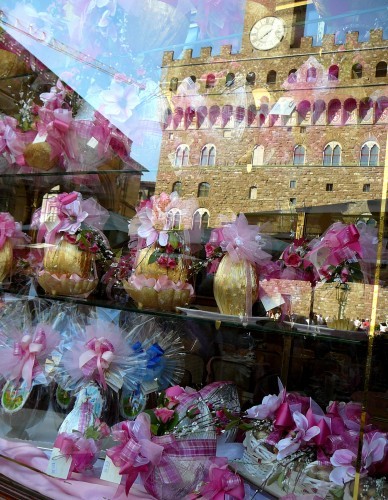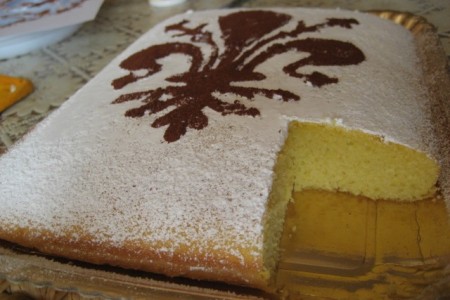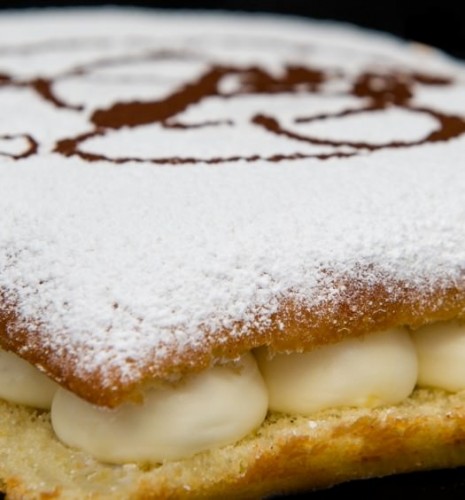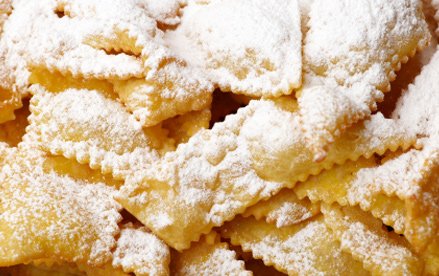Carnival and Easter are the best times for desserts in Italy, especially in Tuscany. I have a sweet tooth, but have never been a big fan of Italian dolce. (I prefer French pastries and cakes.) But that all changes every spring. In previous posts I’ve extolled the virtues of giant Italian chocolate eggs and Colomba di Pasqua (the Easter Dove). Now it’s time to wrap up the quartet of Easter delights that are found in every pastry shop and café for the next two months – schiacciata alla fiorentina and cenci.

Schiacciata alla Fiorentina
Schiacciata alla fiorentina is a large, rectangular, flat, powdered sugar-dusted, citrus sponge cake. The scent of orange peel and vanilla are the predominant notes and it is traditionally served plain, but sometimes filled with slightly sweetened, freshly whipped Chantilly (my favorite) or pastry cream. You know you have the right sweet when you see the stenciled Florentine giglio, the symbolic lily of Florence, dusted over the top in powdered sugar or contrasting cocoa powder.

You can sit down for a small square portion or take home a whole cake. During Carnival and Easter week, you may have to reserve your whole schiacciata alla fiorentina a day ahead of time at the best pasticceria, selecting a filling, or not, and requesting a white or chocolate giglio.
The name confused me in the beginning. In Florence, schiacciata means ‘squashed’ or ‘flattened’ and usually refers to a savory salt and olive oil drenched flat bread (similar to focaccia). There is also schiacciata all’uva in the fall, which is also a traditional bread dough, but layered with grapes from the new harvest. The only thing they all have in common is that they are flat, which perhaps makes sense.
Pellegrino Artusi (born in Forlimpopoli, near Forlì, August 4, 1820 – died in Florence, March 30, 1911), the father of Tuscan cooking talks of stiacciata delle Murate, a cake fed only to condemned prisoners of the Murate Prison in Florence “in the 1700s” before they were sent to be executed, essentially their “last bite of the sweet life.”

Other food historians dispute this since the Murate was a convent until 1808 and Grand Duke Pietro Leopoldo abolished capital punishment in Tuscany in 1786. Perhaps the Murate nuns devised the recipe and were baking the cakes to celebrate Fat Tuesday each spring.
Schiacciata alla fiorentina traditionally included lard in the recipe, but today olive oil or butter or Crisco replaces this.
Today’s schiacciata alla fiorentina is a delicately scented, light cake that’s not too sweet. Artusi’s rule that it be no thicker than the width of two fingers is not always followed. The characteristic flavor, marked by orange juice and zest, and soft, spongy texture, make it a favorite for a mid-morning or afternoon snack and I know people who have it for breakfast up until Lent and then again on Easter Sunday. It pairs well with coffee, tea and a good vin santo.
My favorite places to find schiacciata alla fiorentina in Florence are Bar Pasticceria Giorgio in the Soffiano neighborhood and I Dolci di Patrizio Cosi in Piazza Gaetano Salvemini .
Cenci
The last of my favorite Tuscan Easter treats is cenci. The literal meaning of the word is “rags” and these addictive fried flat strips of dough look like rags. You are supposed to stop eating them when Lent starts, but the bakers of Florence know that is impossible to do. And, anyway, you will have them again at Easter.

The recipe supposedly comes from ancient Rome. Other parts of Italy indulge in the treat during Carnival and so there are many names: bugie (lies) (Piemont, Liguria), chiacchiere (talk) (Lombardy), crostolo, grostolo or galano (Venice), frappa (Emilia), sfrappole and sfrapla (Bologna), crespelle or sprelle (Umbria, Lazio), and meraviglie (wonderful) (Sardenia). Artusi again weighed in saying they are shaped like rags so they should be called cenci.
The dough for cenci is usually not sweet, but flavored with anise or orange liquor or vin santo or grappa. The flattened dough is cut in a variety of shapes (in Florence it’s short raggedy rectangles), fried in hot oil and dusted with powdered sugar.
I love the cenci from the bakery, Pugi, in Piazza San Marco, but others have their own favorite places.
From the beginning of Carnival and for about a week after Easter you will be able to indulge in chocolate eggs, Colomba di Pasqua, schiacciata alla fiorentina, and cenci. After that you will have to wait another year — as it should be.
